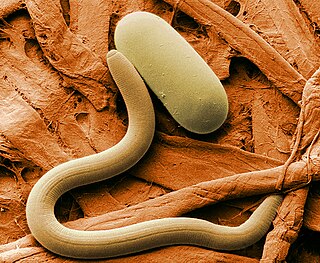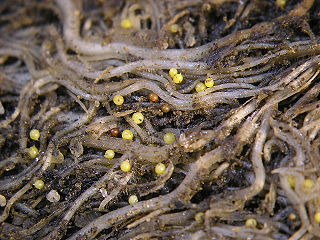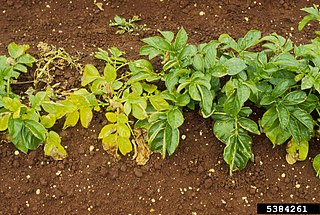
Root-knot nematodes are plant-parasitic nematodes from the genus Meloidogyne. They exist in soil in areas with hot climates or short winters. About 2000 plants worldwide are susceptible to infection by root-knot nematodes and they cause approximately 5% of global crop loss. Root-knot nematode larvae infect plant roots, causing the development of root-knot galls that drain the plant's photosynthate and nutrients. Infection of young plants may be lethal, while infection of mature plants causes decreased yield.

The soybean cyst nematode (SCN), Heterodera glycines, is the most devastating pest to soybean crop yields in the U.S., targeting the roots of soybean and other legume plants. When infection is severe SCNs cause stunting, yellowing, impaired canopy development, and yield loss. The symptoms caused by SCNs can go easily unrecognized by farmers—in some cases there are no warning symptoms before a loss of 30% of the yield. Due to the slight stunting and yellowing, many farmers may mistake these symptoms as environmental problems when in fact they are SCNs. Another symptom of SCNs that may affect farmers' yields is stunted roots with fewer nitrogen-fixing nodules. Due to the fact that soybean cyst nematodes can only move a few centimeters in the soil by themselves, they mostly are spread via tillage or plant transplants. This area of infection will look patchy and nonuniform making diagnosis more difficult for farmers. They can be seen in the roots of summer soybean plants if the roots are taken out very carefully and gently washed with water. The egg masses should be seen as bright white or yellow "pearls" on the roots. The later the roots are pulled the harder it will be to diagnose due to the SCNs female dying and turning a much darker color, forming a "cyst". The best way to know if a field is infected by soybean cyst nematodes is to take a soil sample to a nematologist.

Potato root nematodes or potato cyst nematodes (PCN) are 1-mm long roundworms belonging to the genus Globodera, which comprises around 12 species. They live on the roots of plants of the family Solanaceae, such as potatoes and tomatoes. PCN cause growth retardation and, at very high population densities, damage to the roots and early senescence of plants. The nematode is not indigenous to Europe but originates from the Andes. Fields are free from PCN until an introduction occurs, after which the typical patches, or hotspots, occur on the farmland. These patches can become full field infestations when unchecked. Yield reductions can average up to 60% at high population densities.

Rotylenchulus reniformis, the reniform nematode, is a species of parasitic nematode of plants with a worldwide distribution in the tropical and subtropical regions.

Meloidogyne arenaria is a species of plant pathogenic nematodes. This nematode is also known as the peanut root knot nematode. The word "Meloidogyne" is derived from two Greek words that mean "apple-shaped" and "female". The peanut root knot nematode, M. arenaria is one of the "major" Meloidogyne species because of its worldwide economic importance. M. arenaria is a predominant nematode species in the United States attacking peanut in Alabama, Florida, Georgia, and Texas. The most damaging nematode species for peanut in the USA is M. arenaria race 1 and losses can exceed 50% in severely infested fields. Among the several Meloidogyne species that have been characterized, M. arenaria is the most variable both morphologically and cytologically. In 1949, two races of this nematode had been identified, race 1 which reproduces on peanut and race 2 which cannot do so. However, in a recent study, three races were described. López-Pérez et al (2011) had also studied populations of M. arenaria race 2, which reproduces on tomato plants carrying the Mi gene and race 3, which reproduces on both resistant pepper and tomato.
Pratylenchus brachyurus is a plant parasitic nematode.

Globodera pallida is a species of nematode in the family Heteroderidae. It is well known as a plant pathogen, especially of potatoes. It is "one of the most economically important plant parasitic nematodes," causing major crop losses, and is a model organism used to study the biology of cyst nematodes. Its common names include potato cyst nematode, white potato cyst nematode, pale potato cyst nematode, potato root eelworm, golden nematode, and pale cyst nematode.

Heterodera schachtii, the beet cyst eelworm or sugarbeet nematode, is a plant pathogenic nematode. It infects more than 200 different plants including economically important crops such as sugar beets, cabbage, broccoli, and radish. H. schachtii is found worldwide. Affected plants are marked by stunted growth, wilting, yellowing, decreased yields, and death. While there are many methods of control, crop rotation with non-susceptible plants is preferred.
Xiphinema americanum, the American dagger nematode, is a species of plant pathogenic nematodes. It is one of many species that belongs to the genus Xiphinema. It was first described by N. A. Cobb in 1913, who found it on both sides of the United States on the roots of grass, corn, and citrus trees. Not only is Xiphinema americanum known to vector plant viruses, but also X. americanum has been referred to as "the most destructive plant parasitic nematode in America", and one of the four major nematode pests in the Southeastern United States.
Hemicriconemoides mangiferae is a plant pathogenic nematode.
Heterodera sacchari, the sugarcane cyst nematode, mitotic parthenogenic sedentary endoparasitic nematode. This plant-parasitic nematode infects the roots of sugarcane, and the female nematode eventually becomes a thick-walled cyst filled with eggs. Aboveground symptoms are species specific and are similar to those caused by other Heterodera species. Symptoms include: stunted and chlorotic plants, and reduced root growth. Seedlings may be killed in heavily infested soils.

Tobacco rattle virus (TRV) is a pathogenic plant virus. Over 400 species of plants from 50 families are susceptible to infection.

Pratylenchus is a genus of nematodes known commonly as lesion nematodes. They are parasitic on plants and are responsible for root lesion disease on many taxa of host plants in temperate regions around the world. Lesion nematodes are migratory endoparasites that feed and reproduce in the root and move around, unlike the cyst or root-knot nematodes, which may stay in one place. They usually only feed on the cortex of the root. Species are distinguished primarily by the morphology of the stylets.
Tylenchorhynchus is a genus of nematodes including many species of plant parasites. The classification of stunt nematodes - those including the genus Tylenchorhynchus - is unstable; many newly discovered species within this genus are reconsidered to be actually subspecies. Stunt nematodes such as Tylenchorhynchus and the closely related genera, Anguillulina and Merlinia, include more than 250 known species. Members of these genera possess similar anatomy and may be easily mistaken for one another. Some debate has led to the classification of single species under different names in two distinct genera.

The nematodes or roundworms constitute the phylum Nematoda, with plant-parasitic nematodes also known as eelworms. They are a diverse animal phylum inhabiting a broad range of environments. Less formally, they are categorized as helminths, but are taxonomically classified along with arthropods, tardigrades and other moulting animals in the clade Ecdysozoa, and unlike flatworms, have tubular digestive systems with openings at both ends. Like tardigrades, they have a reduced number of Hox genes, but their sister phylum Nematomorpha has kept the ancestral protostome Hox genotype, which shows that the reduction has occurred within the nematode phylum.
Heterodera zeae, the corn cyst nematode (CCN), is a plant parasitic nematode that feeds on Zea mays (maize/corn). The CCN has a limited economic impact worldwide due to its high soil temperature requirements.
Globodera ellingtonae is one of the potato cyst nematodes and was recently recognized as a new species in the United States. This triggered a quarantine of the fields where it was isolated to prevent the spread of this nematode to other fields.
Pasteuria is a genus of mycelial and endospore-forming, nonmotile gram-positive bacteria that are obligate parasites of some nematodes and crustaceans. The genus of Pasteuria was previously classified within the family Alicyclobacillaceae, but has since been moved to the family Pasteuriaceae.
Pasteuria nishizawae is a mycelial and endospore-forming bacterium parasitic on cyst nematodes of genera Heterodera and Globodera.

Maris Piper is the most widely grown potato variety in the United Kingdom accounting for 16% of the planted area in 2014. Introduced in 1966 it was one of the first potato varieties bred to be resistant to a form of potato cyst nematode, a major pest of potato production in the UK. It has been the most widely grown variety in the UK since 1980 and is suitable for a range of uses including chips, roast potatoes and mashed potatoes.










